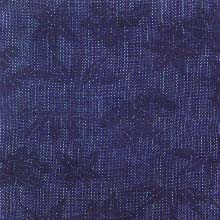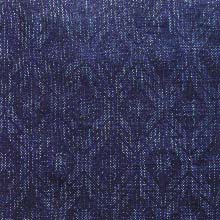Weave (p. 141 )
1. Produced in Hirara City(Miyako Island), Okinawa Prefecture.
2. Characteristics: Hemp fabric, hand-woven with the hand spun threads of "Choma"(ramie). Threads are mud-dyed in indigo. Quality hemp fabric, hand-woven and fulled. As woven with very fine threads, the fabric is strong, smooth and lustrous. Designs are delicate Kasuri patterns, requiring the weaver 2 months to finish 1 "tan"(roll; quantity of cloth enough for one person). Highest quality fabric for summer clothes, paralleling "Echigo Jofu."
3. Uses: Clothes for summer.
4. History: An authorized historical document in Korea has recorded that hemp fabric was first woven in Miyako Island in 1479. But a delicate fabric was first woven in 1583, when a wife of a weaver, who was promoted to produce a good work by the king of Ryukyu, wove a fabric and presented it to the king. Since then, "Miyako Jofu" was designated as an item to be presented to the dynasty and was diversified, bringing about "Iro(color) Jofu." "Miyako Jofu" became popular throughout Japan after the invasion of the Satsuma feudal government into Okinawa in 1609. The Satsuma government levied a poll tax(capitation) on islanders and designate "Miyako Jofu" as the fabric to be collected as tax in 1658. The Miyako Jofu collected was sent to many districts in Japan and became known as "Satsuma Jofu" throughout Japan. The Kasuri pattern "Jofu" in indigo became the main product here as "Iro Jofu" was not much produced. Influenced by the poll tax, which was levied on all women aged 15- 50 without exceptions of ill or physically handicapped, good quality was kept, but the life for the villagers was miserable because they were forced to work in the watch of village officials. The poll tax system continued to 1903. "Miyako Jofu" was exhibited at the World Exhibition in the United States of America in 1875. The WWII temporarily interrupted the production but it was revived in 1948 and designated as the "Important Intangible Cultural Property." It also included the technique of hand spinning, indigo dyeing and hand weaving.




